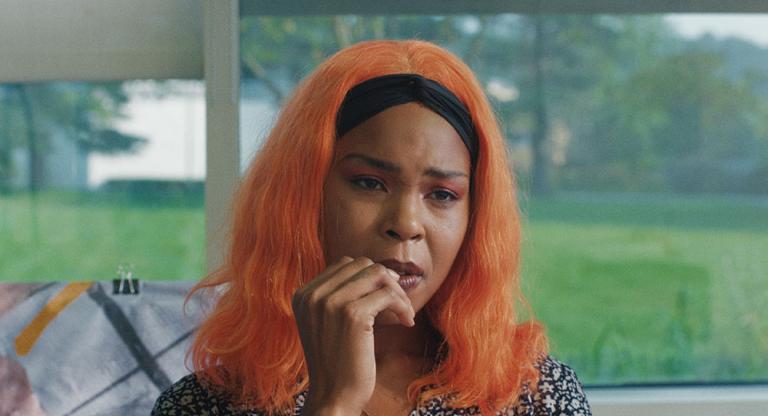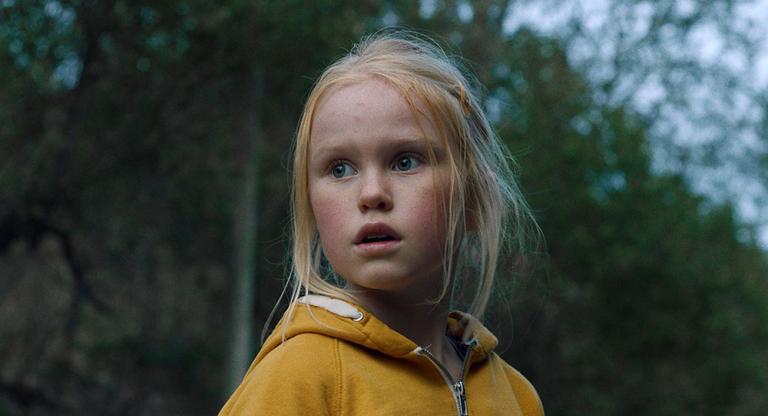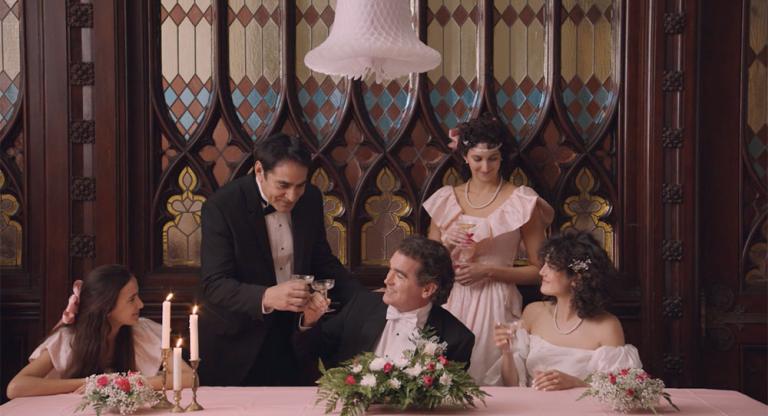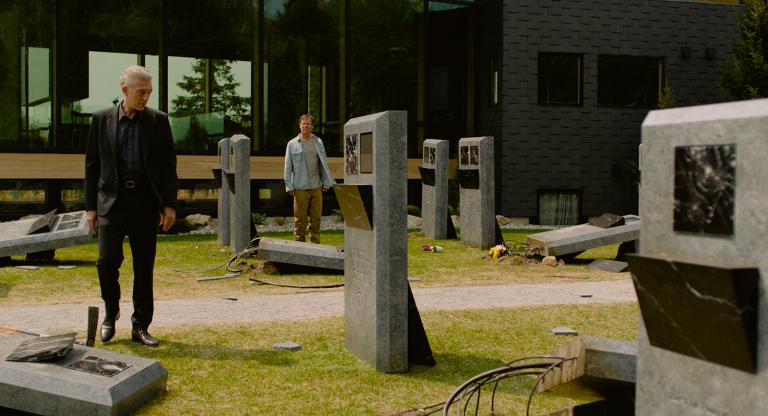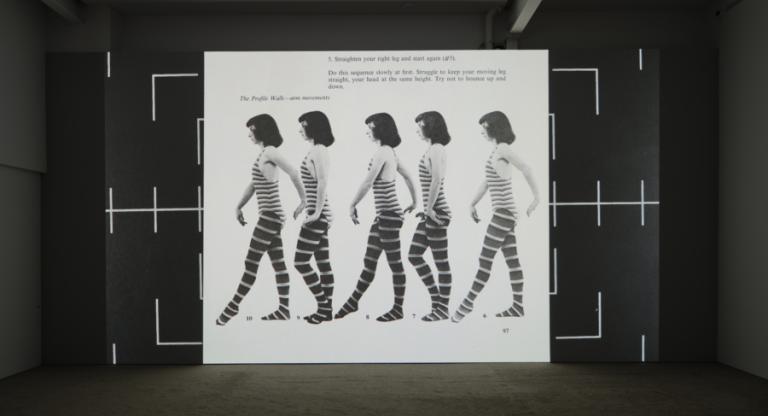In her development of the memoir/novel hybrid, the French writer Annie Ernaux has invented a genre of her own—an exploration of the public sphere through her private experience. Her books build a dialogue between individual biography and collective history, placing her writing at the intersection of socio-political critique, feminist testimony, and literary fiction. Ernaux has set before herself the challenge of translating a personal event into a universal theme, and vice versa, again and again in the course of her nearly fifty-year career, and that challenge is taken up by the French-Lebanese director Audrey Diwan, who has adapted one of the writer’s best-known novels, Happening (2000).
In 1963, Ernaux became pregnant. As a promising young student, striving to enter university and build a life beyond her working-class background, she did not consider carrying the pregnancy to term. But in France, like in many other countries at the time, abortion was still illegal. [As of just before publication, a leaked draft opinion from the Supreme Court indicates that it may soon be illegal again in this country, where many abortions are already banned in several states. – Ed.]
Ernaux’s book fluctuates between her memories and her contemporary considerations of that episode. Diwan's adaptation stays with the young Anne (the impeccable Anamaria Vartolomei) throughout—with tight, protagonist-led camerawork—as she fights to decide her own future. Anne's struggle proves to be extreme and exemplary at the same time. Her friends reject her, her mother (Sandrine Bonnaire) doesn't understand her. The culmination of her odyssey will require the intervention of a “faiseur d'anges” (an “angels maker,” as underground abortionists were poetically called, played by Anna Mouglalis). However brutal the journey, it will reinforce her determination to express her right to life as she wants it.
I spoke with Diwan about the process of adapting Ernaux’s book, the addition of episodes from her own experience into the story, and working with the cast and crew to achieve the long, meticulously composed and choreographed shots that comprise much of the film.

Clara Miranda Scherffig: As a huge fan of Annie Ernaux I was thrilled to see that she worked quite closely with you on the film. In one scene, when Anne is visited by her family doctor for the second time, she says “I'd like a child one day, but not instead of a life.” That line describes her character very well, but I couldn’t trace it in the book, in which Annie Ernaux writes with two voices—one of the past, quoting parts of her diary from 1963, and the one of the present. How did you manage to translate these two voices into the one of the main character?
AD: I’ve known Annie Ernaux’s work for a very long time. I come from literature. I was a producer, I wrote novels myself. And I was just amazed that I discovered [the book] that late, after having an abortion myself and wanting to read on the topic. I came to [Ernaux] to explain my project, the way I wanted to adapt the book. What she's trying to do is to reach the truth of her memories—not trying to create a legend—in the most earnest, brutal way. I cannot do that while making a movie, as it's fiction. And [the book is] autobiographical. So I told her that my project was trying to reach the truth of the instant. Let's see, step by step, minute after minute, how can we embody that experience?
The first thing that I told her is that I didn't want it to be about the writer trying to reach the memories, because this would have set the story in the past. And my project was exactly the opposite, for one good reason: this story set in the past in France is obviously a [reality] in so many countries in the world. So we did agree on that. I asked her a lot of questions about the social-political situation [of] the time, her friends, her parents, what she thought about sex. I was very lucky because she agreed [to] read three versions of the script. She told me from the beginning that she would never try to make the screenplay look like the book, but she would always mention it if something didn't feel right. So I had full freedom, because I knew that she would keep me on the right track. It was a great and blessed collaboration.
CMS: It sounds like a safe environment for you to work in.
AD: It's a luxury, because you can call [Ernaux] and [ask her]— I'll give you an example. When you talk about illegal abortion, you've got the [implication of] sexual life. But there wasn't much about it in that book. So I took part of my own experience. For instance, when Anne watches her friend masturbating on a cushion. It's something that happened to me when I was younger. A friend showed me how to do it. I was able to ask Annie Ernaux if it was right for me to add part of my own experience. It was the perfect combination, the best way not to betray the book, and also to be very intimate, and to involve myself in the story, as Annie Ernaux involves herself—not as much, but still to involve myself with my own experience.
CMS: As you say, different elements changed in your adaptation. The film is set in summer, whereas the book is set in winter. That gives a completely different breath to the atmosphere.
AD: The book gave me the idea because she talks about the sun and the last moments of our innocent youth. And I was thinking also about “what is sexual desire in 1963?” You have these youth in front of your eyes, and it's the same youth as today. They had the same hormonal desire. And for the first time [in] history, they are a social cohort, have places where they can dance, where they can actually be close. But also, if you go through [with] an illegal abortion, or if you help someone, you end up in jail. It’s an intense line of tension and I had the feeling that, in summer, the sun would reveal that. With Anne we are working into the unknown, and into a shadow. So it's very sunny, but then we act in the shadows. It was a way to embody an idea that really matters to me. It was some kind of resistance movement. We help each other silently, giving out addresses that no one should know but us, trying to help that girl. So yeah, the idea of the shadow comes, of course, with the idea of the sun.
CMS: That's beautiful. Also the image of Annie concealing what's happening to her from society. My association with summer was different though, in the sense that it is the season of flirting, hanging out, carelessness—another counterpoint to Anne's experience. Next to her desire to establish herself, to experience pleasure, there are constant reminders of “ordinariness” that emphasize her personal tragedy.
AD: [In the scene where Anne and her girlfriends] are watching the guy playing football, you can hear what the girls are saying. They have problems with their shorts and t-shirts, because they don't have enough [clothes] and they don't know how to wash them. And it's exactly [like] in the book. Like, “Oh, I would love to have those problems, because I have bigger problems now.” It’s [just] light chattering around her, [but] she’s excluded—excluded from the rest of the world by the secrets hiding in her belly.
CMS: In one scene Anne is asked to explain the rhetorical figure of the anaphora—the repetition of one or more words to convey emphasis. This hints at the way you worked with some structural elements of the film, especially words and sound. For instance, the film uses intertitles to describe the passing of time. Furthermore, dialogues quote literary passages or topics from Anne’s pre-university courses to comment on her state of mind. When she discovers that she is indeed pregnant, she joins her friends, and they're repeating the Latin conjugation of agere, which means “to act”—
AD: Yeah, what is action when you can't act? Part of the pleasure of being a filmmaker is this little secret that you share with part of your audience that carefully watches. I mean, the movie works without it. But I carefully work on details, hoping that someone's gonna get it.
[About the intertitles,] the weeks that you see on screen—“first week,” “second week,” etc.—it's based on an idea. The book is based on a diary. At one point in [reading] the book, I wrote [down] a sentence that I kept in mind. Annie Ernaux writes, “Time ceased to be a series of meaningless days punctuated by university talks and lectures. [. . .] It became a shapeless entity growing inside me.” Kind of a horror-movie sentence. So I made the time be something [other] than [a] date. And only at the very end, time is time again, so she can join the rest of humanity, because she was excluded from that also.
CMS: You also work with sighs—breathing—a lot, and silences.
AD: If you work on the movie as a physical experience, you have to use many tools to make the audience be the character. And it's by essence a very silent movie, because it's a story of a girl who hides the secret and can’t share it with anyone. I said to Anamaria [Vartolomei], “We are going to work on silence, using it as the material of the movie.” First we worked on inner monologues. I wrote things, [Vartolomei] co-wrote. At some very painful moments, we would work as mirrors. I made a mistake. [I thought,] “If she's in pain, she's gonna shout.” She does it, and it doesn't work. So we're sitting in front of each other exploring, and I said, “Okay, what if we reverse the process? What if you start breathing as if you were going to have a lack of oxygen? Try not to faint.” I do it, and she does it also. So I can see what she's doing, but she also sees what I am doing. This kind of partnership helped us find the right way to do it.

CMS: There are at least two scenes that are, as probably everyone [tells] you, quite intense, if not very challenging, to watch. But somehow they are just the right length. How did you feel that it was the right moment to say “cut?”
AD: [Finding] the right length was the main matter of doing the movie. So, once again, I'm happy that you mentioned that because [cutting a shot] too short makes ideas be theoretical—you know what's going on, but you don't feel it. When you keep it for a while, even if it's hard for the actress and the crew, then you start to feel what she feels. And if you go too far that way, you become provocative. We tried different lengths until the moment when we felt—when I felt—it's the right length.
In the middle of the movie, [there is] a shot that lasts for seven and a half minutes. I was pretty sure that everybody would tell us about this. I realized that we've done it the right way when nobody mentioned it. It was learning humility. We really struggled to make some of the shots of the movie as a crew, as an orchestra. Whenever she turns her head to look at something, the focus guy—the exact same second—must do the focus wherever she puts her eyes, as the DP’s actually turning around her. That was hard to do. But whenever it's rightly done, nobody will ever notice.
CMS: I'm interested to know what you mean exactly by “a lesson in humility.”
AD: I want to tell you about one shot. I [rewatched] Van Gogh [1991], from Maurice Pialat, last week. At one point Van Gogh is watching Marguerite Gachet playing piano, and the camera is there. He turns around, and suddenly he sees something that interests him. So he jumps out of the window and starts drawing. The camera doesn't stop, it just goes to him slowly, very slowly. You don't even think about it. Then the father of Marguerite Gachet arrives from behind and starts watching. And then Van Gogh says, “The hardest is to do something simple.” I had the feeling that it was not Van Gogh but Pialat speaking. I was thinking, “Oh, I can't agree more.” Your art is to make it look simple. And if you want to be in demonstration, if you want people to see your art, then to me—and it's subjective—you're going the wrong way. At least [that’s] not what interests me the most.
CMS: The meaning of the film outweighs your voice as a filmmaker. However, you employed distinctive camera work. Anne’s character is very bold, but also openly vulnerable. It’s an interesting mix and the camera feels somehow subjugated to her. How did you work on this power dynamic between the main character, who's going through such a hard time, and the camera person, following every step?
AD: Most of the people on my crew are my friends for many years, so [that] changes a lot of things. Laurent Tangy, the DP, we’ve known each other for more than a decade. . . . We already have this common language. He's very instinctive. We felt whenever we were close to her, and whenever we were losing her. We experienced that. I don't do many different [setups], but I do lots of [takes]. I compare it to painting. So we add small details after small details, all the crew together. And at the end, we're like, “Okay, this is a good one.” And [after each take], everybody comes to the small screen, and we watch all together, because we tried to make it right, all of us at the same time.
CMS: I read that you watched several films with Anamaria: Rosetta [1999], by the Dardennes, Son of Saul [2015]—
AD: Vagabond [1985], Elephant [2003], Fish Tank [2009], Girl [2018] by Lukas Dhont.
CMS: Well it's nice that you mention Vagabond. I wanted to ask you how it was to work with Sandrine Bonnaire.
AD: She's from Pialat’s school, obviously. One day I go to Anamaria and Sandrine, and I say, “What about the slapping? Do you want to rehearse?” I don't rehearse on set. But I was like, “Do you know how to do it?” And they were like, “Yeah, don't worry. We know how to do it.” . And then Sandrine gives her the most impressive, real slap I've ever heard. I [dropped] my [monitor] screen. I was like, “Oh my god.” But I know that Anamaria is a huge actress because I was like, “Okay, maybe the next one we're not doing the same way.” And Sandrine and Anamaria say, “Yeah, we need to do it the same way.” And then—the first time you're surprised. The second shot, she knows the slapping is coming. And she never moved. She says the [line] and remains very [still]. I would have escaped, you know, [as a] reflex.
CMS: Going back to the films you were watching, there is one film that doesn't get mentioned because it's probably too close to Happening. Which is Never Rarely Sometimes Always [2020], by Eliza Hittman.
AD: I was so afraid to compare my movie to hers that I haven't seen it yet. I really need to see it. I really want to see it.
CMS: I don’t mean to compare them, but I’d like to relate something that critics and people who have watched both films noticed: they manage to avoid being spectacular, ostentatious, or extreme in the display of such an event—which also gives great dignity to these images. Yet both films go through a certain degree of detachment to represent a person—a body—experiencing abortion (a word never spoken in the film, by the way). I had to think about this sentence from Ernaux’s book: “I feel that my pregnancy is totally abstract”.
AD: I find [abstraction] very interesting. I think it’s the way you protect yourself—your mind, your psyche— while going through this very violent experience. At some moment you have to disconnect from your basic emotions because it’s almost impossible to get through that if you feel and understand every minute of what’s going on—every second of what’s going on. So, at some moment, you have to find a way to survive.
Happening was the Opening Night selection for New Directors/New Films 2022. It will open this Friday, May 6, at IFC Center.

